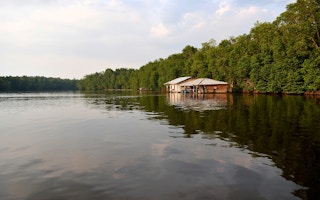Humanity’s consumption of fresh water has long exceeded the rate of replenishment. Now, researchers are warning that this essential natural resource is running out. If we are to reverse this trend, investing in natural solutions is our best hope.
Less than 1 per cent of all water on Earth is accessible or usable fresh water. Most is held in inland wetlands, including rivers, lakes, marshes, peatlands, and underground aquifers. These wetlands are nature’s water harvesters, cleaners, and bankers. By capturing, purifying, storing, and releasing rain and floodwater before releasing it when needed, they enable the global water cycle that ensures a constant supply.
Worldwide, wetlands’ full integration into water planning and management across all economic sectors would bring far-reaching benefits. Sufficient water supplies could stimulate economic growth, reduce conflict, and relieve environmental stress. But that requires significant sustained investment to meet surging demand.
Consumption of fresh water has increased sixfold over the last 100 years, and demand is still rising, with agriculture, industry, and energy accounting for 90 per cent of the total. At least 55 per cent more water will be required by 2050 to meet the demand created by economic growth, urbanisation, and a global population of nearly ten billion people.
Already, there is considerably less water per person now than there was just two decades ago. As a result, over three billion people face severe water shortages, which often fuel violent conflict. By 2050, more than half the world’s people will be water-insecure; in dry regions, climate change will aggravate scarcity.
Climate change is only one threat. Pollution is also exacerbating the water crisis. Unsafe drinking water is a potentially fatal reality for people around the world. Virtually all freshwater sources are now contaminated to some extent; not even Mount Everest’s snowcaps have been spared.
“
Industry, too, must step up as an equal partner in conservation and efficient use. Ecosystem protection and an attractive business environment might once have seemed incompatible. Today, businesses’ very survival depends on a healthy natural environment.
Martha Rojas Urrego, secretary-general, Ramsar Convention on Wetlands
So, why aren’t we saving and protecting wetlands? Their versatility is especially relevant when considering that water crisis ranks among the World Economic Forum’s top five global risks in terms of impact. Their water-harnessing capacities above and below ground – counteracting droughts, floods, and the impact of melting glaciers – are particularly important. And yet, although they provide most of our fresh water, nearly 90 per cent of all wetlands have disappeared since the Industrial Revolution, and the loss is accelerating in tandem with globalisation. Many remaining wetlands are critically endangered.
Wetlands are particularly vulnerable because they are frequently considered wasteland to be converted for farming and development, or disease-ridden areas to be reclaimed. This tendency highlights the lack of understanding of wetlands’ critical role that underpins the world’s water crisis. To ensure safe, secure, and adequate water supplies, we must focus on the connection between human dependence on water and what we do to wetlands.
Yes, there are other options for increasing our water supply, but none is ideal. Seawater desalination creates more problems than it solves. Cloud seeding raises troubling questions. And mass construction of water capture plants requires considerable investment and often disrupts local economies and ways of life. Moreover, unlike wetlands, these options cannot simultaneously provide food, medicine, income for one in seven people, a home for countless species, or mitigate climate change.
With half of global GDP dependent on ecosystem services, saving wetlands should be a top priority in crafting a green recovery from the COVID-19 crisis. Chennai’s revitalisation of ancient wetlands in India to prevent another “day zero” – like the one in 2019, when the city’s water ran out – offers a blueprint for others.
Importantly, we must rethink and overhaul agriculture, by far the biggest consumer of water, to get more “crop per drop.” Incentives for intensive production that disregards wetlands, water pollution, and biodiversity should be phased out quickly. The United Kingdom’s new Environmental Land Management initiative is one example of a programme rewarding farmers who focus on water stewardship and wetland conservation as pillars of their land management. Similar schemes should be scaled globally.
Industry, too, must step up as an equal partner in conservation and efficient use. Ecosystem protection and an attractive business environment might once have seemed incompatible. Today, businesses’ very survival depends on a healthy natural environment. Recognising this, Danone and other companies have committed to water stewardship and watershed protection, while many firms are engaging globally in multi-partner water funds to use sustainable wetland management to meet the needs stemming from rapid urbanisation. Thanks to this type of water fund, Nairobi’s River Tana has generated an extra 27 million litres of water daily in just three years.
Water-stressed countries like South Africa no longer need to be persuaded. More than half the country’s people and two-thirds of the economy are supported by just a small group of wetlands. Policymakers there know that wetland protection and its integration into water management are central to ensuring the secure supplies on which economic development depends.
Wetlands are the planet’s best solutions to the existential issue of freshwater supply. We can have enough here on Earth without needing to search beyond Earth for it. All we must do is protect the natural solutions we already have and use them wisely.
Martha Rojas Urrego is secretary-general of the Ramsar Convention on Wetlands.
Copyright: Project Syndicate, 2021.
www.project-syndicate.org








